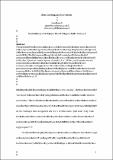Close looking and conviction
Abstract
This article offers theoretical and practical reflections on the operations involved in description and interpretation based on ‘close looking’. Explanations are given of the necessary appeal to contexts of origin or reception in order to disambiguate works of art, the widespread though rarely acknowledged reliance on an attenuated form of intention, and the way in practice that contexts are mobilised in the description or ‘redescription’ of works of art. Wider points made concern scepticism about the idea that works of art might determine their own interpretation (including problems with claims made as part of the phenomenological turn in image studies for the priority of direct or unmediated response to works of art), the quasi-allegorical nature of even ostensibly object-centred interpretation, and consequences of the fact that modernism can function as a kind of context.
Citation
Rose , S 2017 , ' Close looking and conviction ' , Art History , vol. 40 , no. 1 , 156 , pp. 156-177 . https://doi.org/10.1111/1467-8365.12259
Publication
Art History
Status
Peer reviewed
ISSN
0141-6790Type
Journal article
Description
Research for this essay was supported by: the Arts and Humanities Research Council; the Courtauld Institute of Art; and Peterhouse, Cambridge.Collections
Items in the St Andrews Research Repository are protected by copyright, with all rights reserved, unless otherwise indicated.

